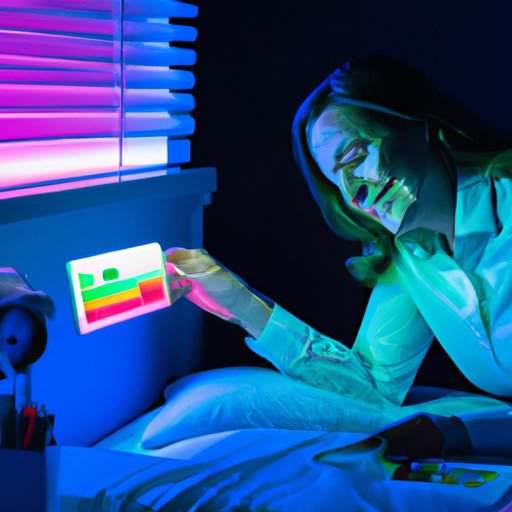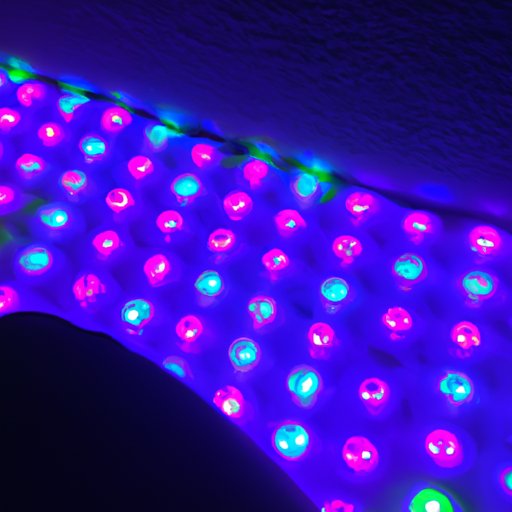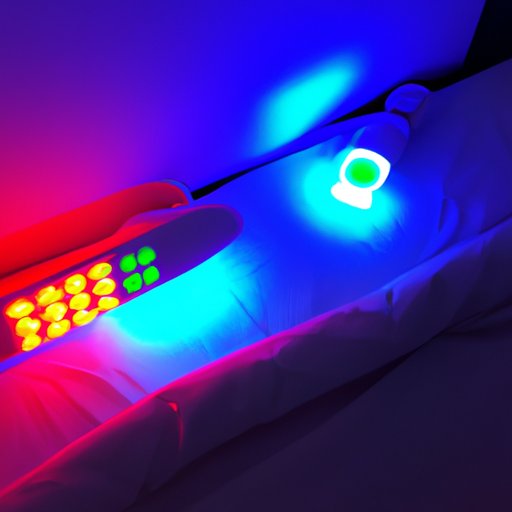Introduction
Light-emitting diode (LED) lights are widely used in everyday life, from illuminating homes and workplaces to lighting up computer screens and televisions. But when it comes to bedrooms, what is the best LED light color for getting a good night’s sleep? In this article, we’ll explore the various effects that different colored LED lights have on the body and investigate the science behind the optimal LED light color for better nights’ sleep.

Examining the Impact of Different LED Light Colors on Sleep Quality
The human body is incredibly sensitive to light, especially in regards to its circadian rhythm, which helps regulate our wake/sleep cycle. Certain wavelengths of light are known to affect the body’s melatonin production, which can lead to difficulty falling asleep or staying asleep. The color of light emitted by an LED light bulb is determined by the type of phosphor coating used. Blue, green, and red LED lights are the most common types of LED lighting used in bedrooms.
Blue LED lights are known to suppress melatonin production more than any other color of light. Studies have found that exposure to blue LED lights before bedtime can cause difficulty sleeping and reduce the amount of time spent in REM sleep. On the other hand, red LED lights have been shown to increase melatonin production and improve sleep quality. Green LED lights appear to have a neutral effect on melatonin production.
In addition to color, another factor to consider is color temperature. Color temperature is measured in Kelvin (K), and a higher color temperature indicates a bluer light, while a lower color temperature indicates a warmer light. Studies have found that LED lights with a color temperature of between 2,500K and 3,500K are the best for improving sleep quality.
Pros and Cons of Different LED Light Colors for Bedrooms
When choosing an LED light color for your bedroom, it’s important to consider the pros and cons of each option. Blue LED lights are often used in offices and other work environments because they help people stay alert and focused. However, blue LED lights can also disrupt the body’s natural sleep-wake cycle, leading to difficulty sleeping and reduced REM sleep.
Red LED lights can be beneficial in bedrooms because they help promote the release of melatonin, which can lead to better sleep quality. Red LED lights also have the added benefit of reducing eyestrain and fatigue, which can help make it easier to fall asleep. However, red LED lights can also make it difficult to stay awake during the day if used too frequently.
Green LED lights may be the best choice for bedrooms because they have a neutral effect on melatonin production. Green LED lights are also known to increase focus and concentration, making them a great choice for studying or working in the bedroom. However, green LED lights can also make it difficult to relax and fall asleep if used too close to bedtime.

Science Behind the Best LED Light Color for Sleep
Researchers have studied the impact of different LED light colors on the body and sleep quality. Studies have found that LED lights with a color temperature of between 2,500K and 3,500K are the best for improving sleep quality. This range of color temperatures is associated with warm white and yellowish hues, which have been shown to stimulate melatonin production and lead to better sleep.
In addition, research has found that blue LED lights are the worst for sleep quality, as they suppress melatonin production and can lead to difficulty sleeping. Red LED lights are beneficial for sleep because they promote the release of melatonin and reduce eyestrain and fatigue. Green LED lights may be the best overall choice for bedrooms, as they have a neutral effect on melatonin production and can help increase focus and concentration.
Conclusion
Choosing the right LED light color for your bedroom can have a significant impact on your sleep quality. Blue LED lights are known to suppress melatonin production and lead to difficulty sleeping, while red LED lights can help promote the release of melatonin and reduce eyestrain and fatigue. Green LED lights have a neutral effect on melatonin production and can help increase focus and concentration. Research has found that LED lights with a color temperature of between 2,500K and 3,500K are the best for improving sleep quality.
Ultimately, the best LED light color for sleep will depend on your individual needs and preferences. It’s important to experiment with different LED light colors to find the one that works best for you. With the right LED light color, you can enjoy a better night’s sleep and improved overall health and wellbeing.
(Note: Is this article not meeting your expectations? Do you have knowledge or insights to share? Unlock new opportunities and expand your reach by joining our authors team. Click Registration to join us and share your expertise with our readers.)
